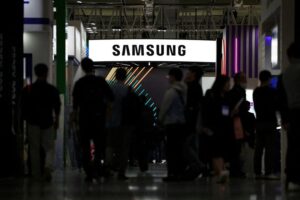Samsung Electronics Faces Challenges Amid Sluggish Chip Sales
In a landscape increasingly dominated by the demand for artificial intelligence (AI) technologies, Samsung Electronics is bracing for a projected 21% drop in its first-quarter profit. This downturn, expected to be announced shortly, highlights the company’s struggles against the backdrop of sluggish sales in its AI chip sector and ongoing losses in contract chip manufacturing.
The Impact of Leadership Changes
As the world’s largest maker of memory chips, Samsung finds itself navigating turbulent waters, particularly following the unexpected passing of co-CEO Han Jong-Hee in late March. His death not only signals a shift in management strategies but also raises questions about the company’s ability to respond swiftly to the rapidly evolving semiconductor market. Samsung’s preliminary earnings report is highly anticipated, as analysts speculate on how these changes may influence operations.
Competition from Rivals
Samsung has increasingly faced challenges in maintaining its profitability. The company has notably fallen behind its key rival, SK Hynix, particularly in the area of high-performance memory chips essential for AI technologies. This competition is fierce, as AI chip leader Nvidia continues to demand cutting-edge semiconductor solutions. Samsung’s struggle to capture this high-end sector has led it to rely heavily on Chinese customers, primarily seeking mid-range chips that are less impacted by U.S. export restrictions.
Changing Market Dynamics
According to Ryu Young-ho, a senior analyst at NH Investment & Securities, demand for AI chips among Chinese customers has decreased in the first quarter following a rush to stockpile earlier, driven by anticipation of new U.S. restrictions. This change has likely contributed to a decline in the share of high-bandwidth memory (HBM) chips in Samsung’s overall DRAM shipments, thereby squeezing profitability in this segment.
Projected operating profits for Samsung during the January-March quarter amount to approximately 5.2 trillion won (around $3.62 billion), significantly down from 6.6 trillion won during the same period last year. Meanwhile, SK Hynix is projected to see more than double its profits compared to the previous year, suggesting a significant market share shift that Samsung will need to address.
Price Volatility and Tariff Challenges
Recent pricing trends indicate a decline in memory chip costs, which has compounded Samsung’s profitability issues. DRAM prices plummeted by roughly 25% in the first quarter compared to the previous year, while NAND flash chip prices have seen an astounding decline of around 50%. These price fluctuations demonstrate Samsung’s vulnerability, particularly due to its substantial exposure to commodity chips.
Additionally, tariff challenges continue to loom large. The reciprocal tariffs imposed by the U.S. government have increased production costs for Samsung’s wide array of products, from smartphones to televisions. Analysts, including Jeff Kim from KB Securities, believe that while Samsung might consider diversifying its manufacturing strategy as a long-term solution, such changes require considerable time to implement.
“If tariffs on consumer electronic devices persist, they will inevitably impact consumer demand,” Kim stated, emphasizing the interconnectedness of tariffs and market performance.
Future Developments in Chip Manufacturing
Looking ahead, Samsung’s contract chip manufacturing business also faces hurdles. The company is likely to postpone the startup of its new U.S. factory from 2026 to 2027 due to unresolved production orders. Originally slated to open in 2024, this delay underscores the challenges Samsung confronts in its foundry business as it operates at a loss.
The estimated operating profit from Samsung’s chip division for Q1 stands at about 1.7 trillion won, slightly lower than 1.9 trillion won in the same quarter last year. Conversely, the mobile and network business is projected to report 3.7 trillion won in profit, up from 3.5 trillion won the previous year, buoyed by increased smartphone shipments despite local currency depreciation.
Conclusion
As Samsung Electronics prepares to announce its first-quarter earnings and navigate an uncertain future, it faces a complex interplay of competitive pressures, market dynamics, and operational challenges. Investors and industry watchers alike will be closely observing how management choices, alongside broader economic conditions, will play out in the coming quarters. For in-depth analysis and updates on the semiconductor industry and major players like Samsung, stay tuned to our insights at Extreme Investor Network.

